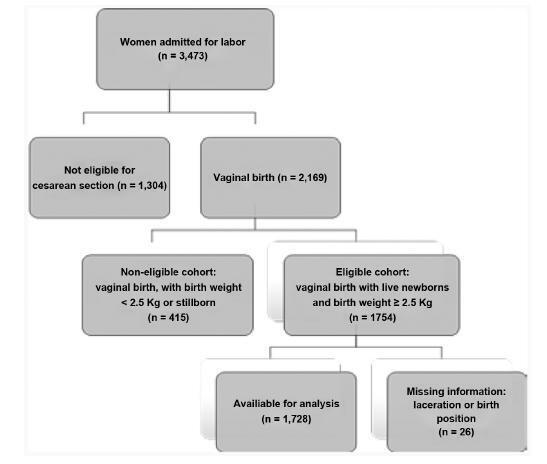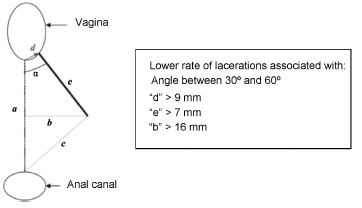-
Original Article11-15-2021
Perineal Lacerations: A Retrospective Study in a Habitual-Risk Public Maternity
Revista Brasileira de Ginecologia e Obstetrícia. 2021;43(8):588-594
Abstract
Original ArticlePerineal Lacerations: A Retrospective Study in a Habitual-Risk Public Maternity
Revista Brasileira de Ginecologia e Obstetrícia. 2021;43(8):588-594
Views140See moreAbstract
Objective
In around 85% of vaginal births, the parturients undergo perineal lacerations and/or episiotomy. The present study aimed to determine the incidence of lacerations and episiotomies among parturients in 2018 in a habitual-risk public maternity hospital in southern Brazil, and to determine the risk and protective factors for such events.
Methodology
A retrospective cross-sectional study. Data were obtained from medical records and analyzed using the Stata software. Univariate and multivariate logistic regressions were performed. Values of p<0.05 were considered significant.
Results
In 2018, there were 525 vaginal births, 27.8% of which were attended by obstetricians, 70.7% by obstetric nurses, and 1.5% evolved without assistance. Overall, 55.2% of the parturients had some degree of laceration. The professional who attended the birth was a significant variable: a greater number of first- and second-degree lacerations, as well as more severe cases, occurred in births attended by nurses (odds ratio [OR]: 2,95; 95% confidence interval [95%CI]: 1,74 to 5,03). Positions at birth that did not enable perineal protection techniques (expulsive period with the “hands-off” method), when analyzed in isolation, determined the risk; however, in the final regression model, this relationship was not confirmed. Although reported in the literature, there were no associations between the occurrence of laceration and age, skin color, or birth weight. In 24% of the births, episiotomy was performed, and doctors performed 63.5% of them.
Conclusion
Births attended by nurses resulted in an increased risk of perineal lacerations, of varying degrees. In turn, those assisted by physicians had a higher occurrence of episiotomy.
-
Original Article12-20-2019
Knowledge, Attitude and Practice of Brazilian Obstetricians Regarding Episiotomy
Revista Brasileira de Ginecologia e Obstetrícia. 2019;41(11):636-646
Abstract
Original ArticleKnowledge, Attitude and Practice of Brazilian Obstetricians Regarding Episiotomy
Revista Brasileira de Ginecologia e Obstetrícia. 2019;41(11):636-646
Views151Abstract
Objective
To determine the prevalence of episiotomy and the factors associated with the knowledge, attitude and practice (KAP) of Brazilian obstetricians in relation to this procedure.
Methods
A KAP survey was conducted with obstetricians working in Brazil. An electronic form containing structured questions previously evaluated using the Delphi method was created in Google Docs and sent by e-mail. A multivariate logistic regression was performed to determine the principal factors associated with adequate KAP. For each dependent variable (knowledge, attitude and practice) coded as adequate (1 = yes; 0 = no), a multiple logistic regression model was developed. Binary codes (1 = yes and 0 = no) were assigned to every independent or predictor variables. Prevalence ratios (PRs) and their respective 95% confidence intervals (95%CIs) were calculated as measures of relative risk, at a significance level of 5%.
Results
Out of the 13 thousand physicians contacted, 1,163 replied, and 50 respondents were excluded. The mean episiotomy rate reported was of 42%. Knowledge was determined as adequate in 44.5% of the cases, attitude, in 10.9%, and practice, in 26.8% of the cases.
Conclusion
Most respondents had inadequate knowledge, attitudes and practices regarding episiotomy. Although some factors such as age, teaching, working in the public sector and attending congresses improved knowledge, attitude and practice, we must recognize that episiotomy rates remain well above what would be considered ideal. Adequate knowledge is more prevalent than adequate attitude or practice, indicating that improving knowledge is crucial but insufficient to change the outlook of episiotomies in Brazil.
Key-words attitudes in healthDeliveryEpisiotomyhealth knowledgeObstetricsPerineumpractices in healthSee more -
Original Article11-07-2019
Do We Know How to Avoid OASIs in Non-Supine Birth Positions? A Retrospective Cohort Analysis
Revista Brasileira de Ginecologia e Obstetrícia. 2019;41(10):581-587
Abstract
Original ArticleDo We Know How to Avoid OASIs in Non-Supine Birth Positions? A Retrospective Cohort Analysis
Revista Brasileira de Ginecologia e Obstetrícia. 2019;41(10):581-587
Views180See moreAbstract
Objective
To evaluate the association between the upright and supine maternal positions for birth and the incidence of obstetric anal sphincter injuries (OASIs).
Methods
Retrospective cohort study analyzed the data of 1,728 pregnant women who vaginally delivered live single cephalic newborns with a birth weight of 2,500 g. Multiple regression analyses were used to investigate the effect of the supine and upright positions on the incidence of OASIs after adjusting for risk factors and obstetric interventions.
Results
In total, 239 (13.8%) births occurred in upright positions, and 1,489 (86.2%) in supine positions. Grade-III lacerations occurred in 43 (2.5%) patients, and grade-IV lacerations occurred in 3 (0.2%) women. Supine positions had a significant protective effect against severe lacerations, odds ratio [95% confidence interval]: 0,47 [0.22- 0.99], adjusted for the use of forceps 4.80 [2.15-10.70], nulliparity 2.86 [1.44-5.69], and birth weight 3.30 [1.56-7.00]. Anesthesia (p<0.070), oxytocin augmentation (p<0.228), shoulder dystocia (p<0.670), and episiotomy (p<0.559) were not associated with the incidence of severe lacerations.
Conclusion
Upright birth positions were not associated with a lower rate of perineal tears. The interpretation of the findings regarding these positions raised doubts about perineal protection that are still unanswered.

-
Review Article06-01-2016
Selective Episiotomy: Indications, Techinique, and Association with Severe Perineal Lacerations
Revista Brasileira de Ginecologia e Obstetrícia. 2016;38(6):301-307
Abstract
Review ArticleSelective Episiotomy: Indications, Techinique, and Association with Severe Perineal Lacerations
Revista Brasileira de Ginecologia e Obstetrícia. 2016;38(6):301-307
Views200See moreAbstract
Introduction
Episiotomy is a controversial procedure, especially because the discussion that surrounds it has gone beyond the field of scientific debate, being adopted as an indicator of the "humanization of childbirth". The scientific literature indicates that episiotomy should not be performed routinely, but selectively.
Objectives
To review the literature in order to assess whether the implementation of selective episiotomy protects against severe perineal lacerations, the indications for the procedure, and the best technique to perform it.
Methods
A literature search was performed in PubMed using the terms episiotomy or perineal lacerations, and the filter clinical trial. The articles concerning the risk of severe perineal lacerations with or without episiotomy, perineal protection, or episiotomy techniques were selected.
Results
A total of 141 articles were identified, and 24 of them were included in the review. Out of the 13 studies that evaluated the risk of severe lacerations with and without episiotomy, 5 demonstrated a protective role of selective episiotomy, and 4 showed no significant differences between the groups. Three small studies confirmed the finding that episiotomy should be performed selectively and not routinely, and one study showed that midline episiotomy increased the risk of severe lacerations. The most cited indications were primiparity, fetal weight greater than 4 kg, prolonged second stage, operative delivery, and shoulder dystocia. As for the surgical technique, episiotomies performed with wider angles (> 40°) and earlier in the second stage (before "crowning ") appeared to be more protective.
Conclusions
Selective episiotomy decreases the risk of severe lacerations when compared with the non-performance or the performance of routine episiotomy. The use of a proper surgical technique is fundamental to obtain better results, especially in relation to the angle of incision, the distance from the vaginal introitus, and the correct timing for performing the procedure. Not performing the episiotomy when indicated or not applying the correct technique may increase the risk of severe perineal lacerations.

-
Original Article02-06-2008
Teenage pregnancy outcome
Revista Brasileira de Ginecologia e Obstetrícia. 2008;30(12):620-625
Abstract
Original ArticleTeenage pregnancy outcome
Revista Brasileira de Ginecologia e Obstetrícia. 2008;30(12):620-625
DOI 10.1590/S0100-72032008001200006
Views146See morePURPOSE: to compare delivery and pregnancy follow-up among adolescent and non-adolescent pregnant women whose delivery occurred in a tertiary hospital from Região de Lisboa (Portugal). METHODS: retrospective study with 10,656 deliveries. Pregnancy follow-up, delivery type, need of episiotomy and severe lacerations, Apgar index at the fifth minute and the delivery weight have been evaluated. The pregnant women were divided into two groups, over and under 20 years old. The group with women under 20 was further subdivided in pregnant women under or over 16. The χ2 test has been used for statistical analysis. RESULTS: adolescents presented worse follow-up: first appointment after 12 weeks (46.4 versus 26.3%) and less than four appointments (8.1 versus 3.1%), less dystocia (21.5 versus 35.1%), less caesarian sections (10.6 versus 20.7%), and lower need for inducing labor (16.5 versus 26.5%). There was no significant difference concerning gestational age at delivery and ratio of low weight newborns. Among adolescents, the ones under 16 had more low weight newborns (12 versus 7.4%) and more deliveries between 34 and 37 weeks (10.8 versus 4.2%). CONCLUSIONS: in a hospital attending adolescents with social and psychological support, the fact of them having had a worse follow-up in the pre-natal phase, their performance has not been worse. Nevertheless, special attention might be given to pregnant women under 16.


